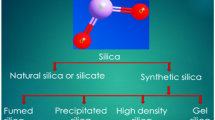Abstract
In this study, recovered silica fillers from pyrolysis and geothermal sources, referred to as ‘rSilica’ and ‘geoSilica’, respectively, have been mixed with epoxidised natural rubber (ENR) to determine whether they can be used to improve the sustainability of ‘green’ tyre tread compounds. The effect of using silica recovered by a geothermal and pyrolysis process as filler in an ENR compound with and without X50S silane coupling agent was investigated in this study. Both recovered silicas also have been characterised and the physical and mechanical properties of the filled ENR compounds measured. All the results obtained have been compared with the industrial silica grade of Zeosil 1165. Based on the test results obtained, rSilica did show reasonably good physical properties such as tensile strength, hardness and abrasion resistance as well as good processing characteristics compared to the commercial-grade silica (Zeosil). rSilica-filled ENR compounds with silane also showed better physical properties than the non-silane compound, which indicates that rSilica still can react with the silane, despite the fact that the amount of silanol groups on the rSilica surface were reduced by the pyrolysis process.





Similar content being viewed by others
Data availability
All datasets generated during this study are available from the corresponding author upon reasonable request.
References
V Chapman, S Cook, RT Davies, J Patel, JL Clark (2009) Microdispersion of Silica in Tire Tread Compounds based on Epoxidized Natural Rubber. Paper presented at the Fall 176th Technical Meeting of the Rubber Division of the American Chemical Society Inc, Pittsburgh, PA, 12–15 October 2009
Iler RK (1979) The chemistry of silica. Wiley, New York
Meon W, Blume A, Luginsland HD, Uhrlandt S (2004) Chapter “Silica and Silane.” In: Rodgers B (ed) Rubber compounding chemistry and applications. Marcel Dekker, New York, Basel
Hewitt N (2007) Compounding precipitated silica in elastomers. William Andrew Publishing, Norwich, NY, pp 1–21
Brydson JA (1988) Rubber materials and their compounds. Elsevier Applied Science, Amsterdam, pp 409–411
K Kato, K Mogi, A Ueda, K Ishimi (2000) Recovery of Silica from the Sumikawa Geothermal Fluids by Addition of Cationic Nitrogen-Bearing Reagents. Proceeding World Geothermal Congress, Kyushu-Tohuku, Japan, 28 May—10 June, 2000
Regulation (EC) No 1222/2009 of the European Parliament and of the Council of 25 November 2009 on the labelling of tyres with respect to fuel efficiency and other essential parameters
John Dinkel (1995) Where the Silica Meets the Road, Discover retrieved 11-01-2016 from: https://www.discovermagazine.com/technology/where-the-silica-meets-the-road
PA Ita (2005) “Filler Requirements In the Tire Industry: Carbon Black & Precipitated Silica”, Tire Technology Expo & Conference, Koln Messe, Cologne, Germany
Michelin (2003) The tyre rolling resistance and fuel savings. Société de Technologie Michelin. Retrieved 20-08-2020 from: http://www.docenti.ing.unipi.it/guiggiani-m/Michelin_Tire_Rolling_Resistance.pdf
PJ Martin, AV Chapman, S Cook, RT Davies, A Kępas-Suwara (2011) Green Tire Tread Compounds with Improved Dispersion Based on Silica-Reinforced Epoxidized Natural Rubber, Fall 180th Technical Meeting of the Rubber Division of the American Chemical Society Inc, Cleveland, OH October 11–13
Rahman IA, Vejayakumaran P, Sipaut CS, Ismail J, Chee CK (2009) Size-dependent physicochemical and optical properties of silica nanoparticles. Mater Chem Phys 114:328–332. https://doi.org/10.1016/j.matchemphys.2008.09.068
Zhuralvlev LT (2000) The surface chemistry of amorphous silica. Zhuravlev model, colloids and surfaces A: physicochem. Eng Aspects 173:1–38
Okkerse C, in: BG Linsen, (eds) (1970) Phisical and chemical aspect of absorbents and catalists (chapter 5). Academic Press, London, p 214
Goerl U, Hunsche A, Mueller A, Koban HG (1997) Investigations into the silica/silane reaction system. Rubber Chem Technol 70(4):608–623
Sarkawi SS, Kaewsakul W, Sahakaro K, Dierkes WK, Noordermeer JWM (2015) A review on reinforcement of natural rubber by silica fillers for use in low-rolling resistance tyres. J Rubber Res 18(4):203–233
Zhang H, Gao Y, Li F, Zhang Z, Liu Y, Zhao G (2016) Influence of silane coupling agents on vulcanised natural rubber: dynamic properties and heat buildup. Plast Rubber nadn Compos 45(1):9–15
Ten Brinke JW, Debnath SC, Reuvekamp LAEM, Noordermeer JWM (2003) Mechanistic aspects of the role of coupling agents in silica-rubber composites. Compos Sci Technol 63:1165–1174
Varughese S, Tripathy DK (1992) Chemical interaction between epoxidized natural rubber and silica: studies on cure characteristics and low-temperature dynamic mechanical properties. J Appl Polym Sci 44:1847–1852
Ismail H, Chia HH (1998) The effects of multifunctional additive and vulcanization systems on silica filled epoxidized natural rubber compounds. Eur Polymer J 34(12):1857–1863
Ismail H, Chia HH (1998) The effects of multifunctional additive and epoxidation in silica filled natural rubber compounds. Polym Testing 17:199–210
Sarkawi SS, Che Aziz AK, Abdul Rahim R, Abdul Ghani R, Kamaruddin AN (2016) Properties of epoxidized natural rubber tread compound: the hybrid reinforcing effect of silica and silane system. Polym Polym Compos 24(9):775
Acknowledgements
The works described were part of the PhD study done at the Department of Material, University of Loughborough under the supervision of Dr. Jane Clarke from 2015 to 2019. The author thanked the Malaysian Rubber Board for its full sponsorship of the study.
Author information
Authors and Affiliations
Corresponding author
Ethics declarations
Conflict of interest
The authors declared that they have no conflict of interest in connection with the work submitted.
Additional information
Publisher's Note
Springer Nature remains neutral with regard to jurisdictional claims in published maps and institutional affiliations.
Rights and permissions
Springer Nature or its licensor (e.g. a society or other partner) holds exclusive rights to this article under a publishing agreement with the author(s) or other rightsholder(s); author self-archiving of the accepted manuscript version of this article is solely governed by the terms of such publishing agreement and applicable law.
About this article
Cite this article
Zaeimoedin, T.Z., Clarke, J. & Che Aziz, A.K. Improving the sustainability of ‘green’ tyre tread compound by using recovered silica filler. J Rubber Res 26, 37–46 (2023). https://doi.org/10.1007/s42464-023-00196-5
Received:
Accepted:
Published:
Issue Date:
DOI: https://doi.org/10.1007/s42464-023-00196-5




